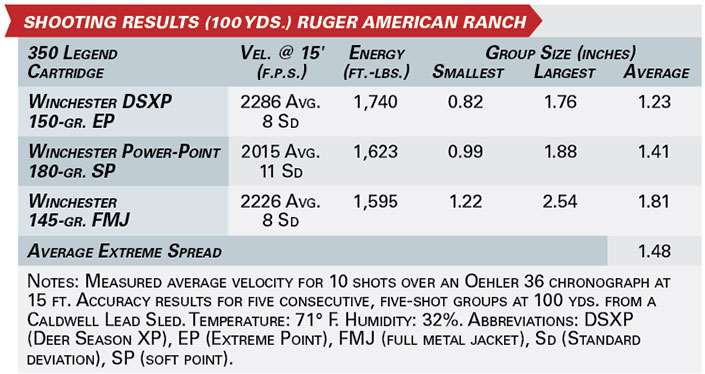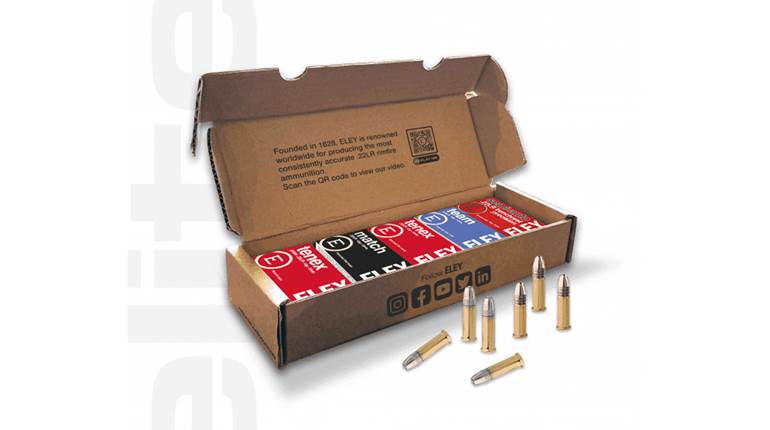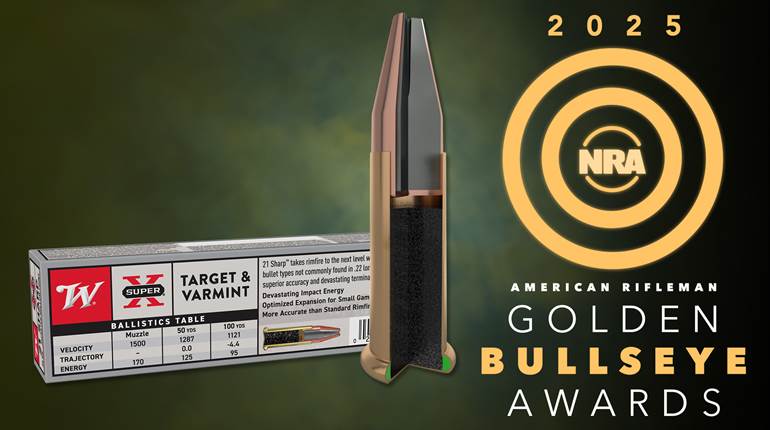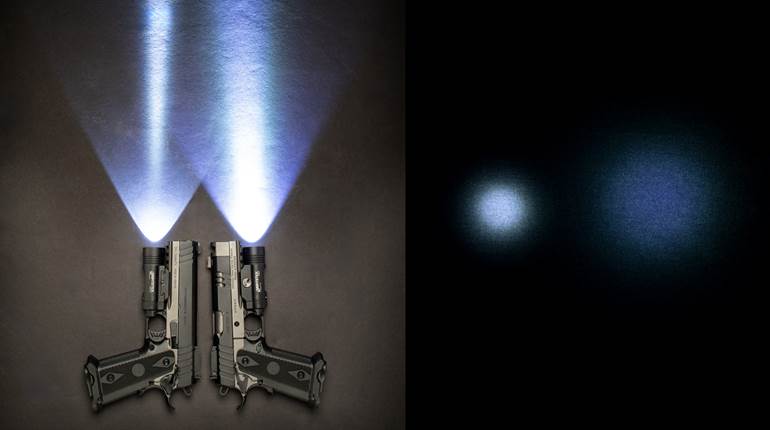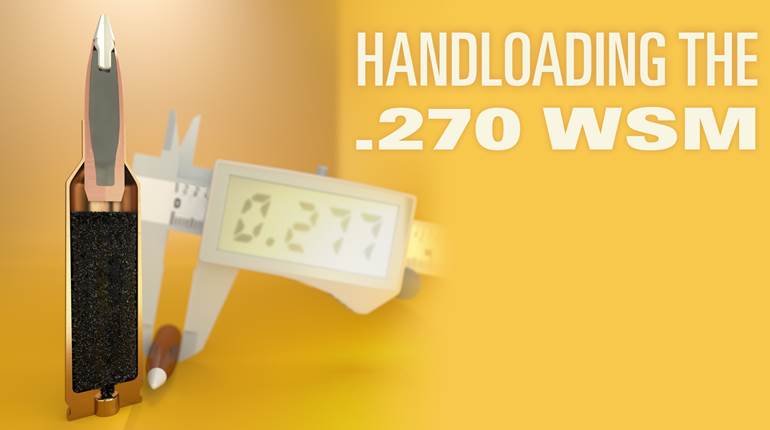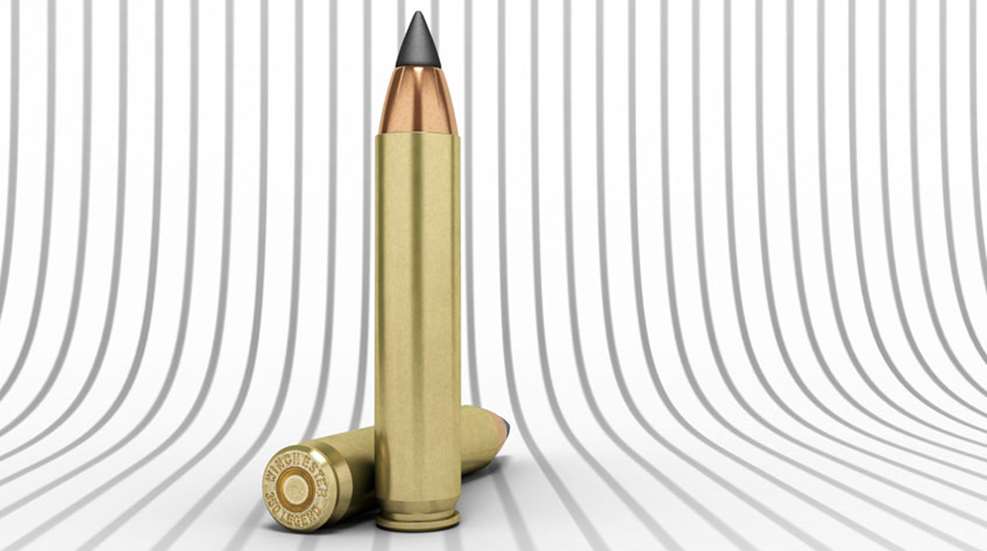
Pouring time and capital into the development of a new chambering is an incredibly dicey endeavor for an ammunition manufacturer, even more so when that design occupies a segment of cartridgedom that has historically been met with disinterest by American shooters. And few rifle calibers have consistently drawn a collective yawn from the firearm community as thoroughly as has the .35. Often attempted and often failed—.35 Remington and .35 Whelen being the only contemporary options that can be considered even moderately commercially successful—a .35-cal. rifle cartridge seems like an odd choice for Winchester Ammunition (winchester.com) to make for its first new center-fire chambering since the WSSMs hit the market in 2004.
Yet the company just might be onto something, if Internet and gun show chatter account for anything, as the sheer amount of buzz that 350 Legend has generated since its announcement at SHOT Show 2019 seems to indicate that American shootists are now more than willing to give the .35 caliber another look. And that ardor is not limited only to consumers, as, perhaps just as importantly, the firearm industry itself has also enthusiastically embraced the cartridge to an uncommon degree. At the time of its January rollout, Winchester Repeating Arms and CMMG were each already poised to announce a number of SKUs chambered to fire 350 Legend (14 variants of the XPR bolt-action and three versions of the Resolute AR, respectively). By the NRA Annual Meetings, three months later, Ruger had also gotten onboard with three compatible models of its own—two American Rifle Ranch bolt guns and an AR-15. And, just prior to press time, CVA, Mossberg, Rock River Arms, Savage, and Shaw Barrels & Rifles joined the fray with 350 Legend guns.

Probably most telling of all, two competing ammunition makers (Federal and Hornady) have already acceded to the merits of Winchester’s design by introducing loads of their own. Given how many cartridge options we already have—and how stubbornly loyal to our favorites and resistant to accept anything unfamiliar that we can be—broad support by the industry is absolutely vital to a nascent design’s longevity. And it’s exceedingly rare for so many big names to line up behind a newborn chambering so quickly.
Of course, all the attention in the world wouldn’t mean a thing if 350 Legend didn’t perform, and after having the chance to evaluate it for the past few months, I’m excited by the potential I see. At first blush, the design seems simplistic, but the deeper you dive into why Winchester created the cartridge, the more well-thought-out it appears. The firm has sagely designed 350 Legend to leverage two of its core competencies—the manufacture of .223 Remington cases and the production of 0.357"-diameter projectiles—decisions that greatly streamline the production process, resulting in deep savings for both the company’s bottom line and the customer’s wallet. Yes, its straight-wall design makes it particularly enticing for those within that specific hunting niche, but the performance, economy and shootability of 350 Legend will endear it to a great many of the rest of us, as well.
Development of 350 Legend began in mid-2017 with the determination by Winchester that there was an unmet need in the marketplace for a medium-bore, straight-wall cartridge. Previously, several Midwestern states had established hunting seasons for shotguns and muzzleloaders only, therefore banning center-fire-rifle use by default. In recent years, some of those states have begun to loosen the restrictions slightly by also permitting the use of certain straight-wall cartridges (that meet specific projectile-diameter and case-length parameters) for the purposes of hunting. As a result, the few existing straight-wall rifle cartridges meeting these criteria have experienced unexpected windfalls in popularity, as sportsmen in the affected states have flocked to them—with the .450 Bushmaster being perhaps the biggest beneficiary.
But, while a capable hunting round, .450 Bushmaster remains expensive, elusive and a bit punchier on the shoulder than some hunters may appreciate. Winchester’s engineers felt they could do better on all three accounts, and their research kept bringing them back to the .35 caliber. The ultimate fruits of their labor were submitted to the Sporting Arms and Ammunition Manufacturers’ Institute’s (SAAMI) technical committee at the group’s June 2018 meeting, and were subsequently accepted during its January 2019 session—with 350 Legend’s maximum cartridge and minimum chamber standards entering the public domain at that time. A similar process seeking approval from CIP (Europe’s version of SAAMI) has already begun.
As far as cartridge design goes, it would be hard to come up with something less complicated than the 350 Legend. Based loosely on the .223 Rem.’s case, and using the same 0.378" case head and a similarly rebated rim, the 350 Legend’s body measures 0.390" wide forward of the extractor groove, and while it obviously has no shoulder, the case does taper ever so slightly back to 0.378" at its mouth to aid in extraction. Given its rebated rim and lack of a shoulder, headspacing on the cartridge mouth (like the vast majority of semi-automatic handgun chamberings) is the only method open to 350 Legend.
Case length is specified as 1.710", compared to 1.760" for .223 Rem., and case capacity averages around 36.5 grs./water. Maximum Cartridge Overall Length (C.O.L.) is set at 2.260"—identical to that of .223 Rem.—meaning that 350 Legend will fit in .223 Rem.-length actions without issue. Maximum average pressure (MAP) likewise has been set by SAAMI at 55,000 p.s.i., again matching the .223’s standard.
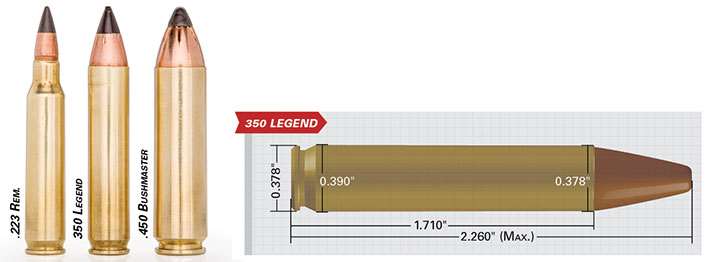
Taken together, the two above figures (in conjunction with its identical case head) open 350 Legend up to potential compatibility with the vast assortment of .223 Rem.-chambered autoloaders on the market (after a barrel change, of course), an exceedingly forward-thinking decision on Winchester’s part. The two cartridges’ geometries, however, differ enough that dedicated 350 Legend magazines are required—the guide ribs just forward of the rounds’ shoulders in .223 AR magazines preclude proper stacking of 350 Legend within the detachable boxes—and standard .223 Rem. magazines can’t just be modified by the end user.
On the positive side, 350 Legend’s case diameter allows for the use of a double-feed magazine design, which means that the new cartridge’s magazines are as quick and easy to load as a standard .223 Rem. magazine. The dual, staggered columns also mean that 350 Legend doesn’t suffer from the same capacity penalty as does the .450 Bushmaster, which is broad enough to require that the rounds be stacked atop each other in a single pillar. As a result, a 10-round 350 Legend AR-15 magazine has the same familiar profile as a 10-round .223 AR-15 magazine.
The dimensions published by SAAMI specify a bullet diameter of “0.3570 – 0.0030,” which allows for some flexibility on Winchester’s part, and pulling the bullets from several loaded cartridges revealed that each was 0.355" in diameter. This was a somewhat curious discovery, as virtually all .35-cal. center-fire rifle chamberings that came before the 350 Legend make use of either 0.3585"- or 0.3590"-diameter projectiles, and bullets in the 0.354" to 0.357" range are more frequently encountered in handgun cartridges. However, the company assures me that the projectiles used in each of its 350 Legend loads were specifically developed for the new cartridge, were designed to operate at rifle velocities and were not simply repurposed from the company’s handgun chamberings of similar diameter.
Winchester is among the leaders in the entire ammunition industry in terms of high-volume production of both .223 Rem. cases and .357-cal. projectiles, and by designing 350 Legend to essentially utilize both, the company can bring major cost-cutting forces to bear in its manufacture. All cartridge cases start life as “cups” that are stamped from strips of brass. By using the same diameter case head for both .223 Rem. and 350 Legend, Winchester can quickly and easily convert a manufacturing cell fabricating one cartridge to begin forming the other by just changing out a few contact tools. In much the same way, due to their diameter commonality, by just switching a few pieces of quick-change equipment, a cup-and-draw press that had been making 9 mm Luger or .357 Mag. projectiles can be producing 350 Legend bullets in just a matter of hours.
As a result, Winchester claims it can build the brand new 350 Legend for not much more than it can make .223—the most economical center-fire rifle cartridge in the world. Imagine being able to afford practicing with your favorite deer rifle, as much as you want, all year round! While the company itself doesn’t set shelf prices for its ammunition, a quick check of multiple online retailers would seem to bear out this prediction: 350 Legend prices on both Brownells (brownells.com) and MidwayUSA (midwayusa.com) were all within $3 per box of 20 as the comparable .223 Rem. load—and some were identically priced. I found the FMJs to be down between 50 and 60 cents a round and the hunting loads were around $1 to $1.20 per cartridge.
At launch, Winchester announced five inaugural loads for 350 Legend: a 145-gr. FMJ; a 150-gr. Deer Season XP; a 180-gr. Power-Point; a 160-gr. Power Max Bonded; and a 265-gr. Super Suppressed. As of mid-June, the former three loads were already shipping to retail shelves across the country, with the latter two expected to arrive by the end of the calendar year. In order to properly evaluate 350 Legend, and the first crop of firearms offered to chamber it, I reached out to my contacts at Winchester Ammunition and asked them to send me a pile of each of the three loads currently available (Deer Season XP, Power-Point and the FMJs). I also got in one rifle each from the first three firearm manufacturers to join the 350 Legend game—a Winchester Repeating Arms XPR Compact, a CMMG Resolute 300 and a Ruger American Rifle Ranch. At the time of my testing, Federal (160-gr. Fusion, 180-gr. Power-Shok and 180-gr. Non-Typical) and Hornady (170-gr. American Whitetail) had both announced their respective loads, but none arrived in time to be included in the evaluation.
Velocities of each load vary by bullet weight, but according to Winchester company literature, all four supersonic options generate a bit less than 1,650 ft.-lbs. of energy at the muzzle through a 16" barrel and a bit more than 1,750 ft.-lbs. of energy at the muzzle through a 20" barrel. Both my CMMG and Ruger test guns had 16" barrels, while the XPR has a 20" tube, and my own chronograph testing more or less coincides with Winchester’s numbers—although I did find Deer Season to run a bit hotter than prescribed through all three guns, while the Power-Points and FMJs were a bit slower than advertised.
Energy-wise, 350 Legend’s closest modern analog is probably .35 Rem., although the older cartridge operates at much lower pressures (33,500 p.s.i.), uses 0.359"-diameter projectiles often weighing 200 grs. or more, and its longer, bottlenecked case is neither AR-15-friendly nor viable for use in straight-wall states. The ballistic performance of 350 Legend doesn’t approach that of .35 Whelen or any of the various magnums, but then again neither does the recoil—the larger .35 cals. being known for smacking the hunter nearly as severely as the hunted.
Given the long-range craze that has seized the gun community in recent years, we typically talk a lot about ballistic coefficients in cartridge stories, but this is not a long-range chambering, and it shouldn’t be employed as such; G1s are listed on the boxes, and for all supersonic options the figures are sub-0.225. Winchester designed 350 Legend to be an effective hunting cartridge out to about 250 yds. and no more—trajectory (and energy) falls off pretty precipitously beyond that.
The Deer Season XP and Power Max Bonded options are primarily intended for the pursuit of thinner-skinned game such as deer and antelope, with the 180-gr. Power-Points also being up to the task of harvesting tougher critters like feral pigs and black bear. A 150-yd. zero is pretty much perfect for 350 Legend, using any of the three above hunting loads, and either a 16" or 20" barrel; impacts will be between 1" to 2" high at 50 yds., between 1.5" to 2.5" high at 100 yds. and between 4.5" and 5.5" low at 200 yds. These numbers mean the hunter is assured a point-blank hit to the vitals at all but the outer fringe of 350 Legend’s entire effective range.
Far more pertinent to a discussion of 350 Legend than ballistic coefficients are sectional density values. Sectional density (SD) is a figure that conveys how well an object’s shape allows it to overcome resistance along a given axis. Found by dividing the weight of the bullet in pounds by the square of its diameter in inches, within the context of terminal ballistics, sectional density is used as a measure of a projectile’s ability to continue penetrating after coming into contact with its target media. In light of the formula, heavy-for-caliber projectiles of a specific diameter will naturally have higher SDs than lighter bullets.
Conventional wisdom states that projectiles with SDs above 0.300 are superb penetrators, while bullets with sub-0.200 values are generally not suitable for anything thicker and more resilient than varmints—which is a helpful basic rule of thumb in many instances, but it’s also misleadingly simplistic. In the past I’ve heard ballisticians talk about how sectional density provides an incomplete picture of a cartridge’s ability to penetrate, but it wasn’t until my recent experience with 350 Legend that I truly got to see this firsthand.
On one hand, the SD of Winchester’s 150-gr. (relatively light for the .35 cal.) 350 Legend Deer Season XP load comes to only 0.170—which should make it a very poor penetrator given the above guideline—falling well short of the 0.230 SD that some would argue is necessary for use on deer-size game. However, on the other hand, I’ve personally witnessed that same load zip straight through both sides of numerous wide-bodied Missouri whitetails with gusto. If SDs told the whole penetration story, that shouldn’t be possible. It all comes down to bullet construction and velocity; as noted in the formula above, sectional density only accounts for the projectile’s diameter and mass—and doesn’t take into consideration factors such as jacket thickness, the hardness of the bullet, impact velocity or the projectile’s rate of expansion. Despite its underwhelming SD, hunters who prefer “two-hole” loads that reliably exit their quarry will find 350 Legend’s Deer Season XP to be an excellent penetrator.
To further elaborate on my experience with 350 Legend’s real-world performance, I was one of six hunters able to participate in the cartridge’s initial field testing: a November whitetail hunt in Pike County, Mo. Whitetails grow nice and big in Missouri, which made them useful penetration-testing mediums for similar game throughout the country. Using 20"-barreled XPR Compacts, six deer were brought down in seven shots, that extra round being more an act of mercy than necessity. With shot distances ranging from 13 yds. to 200 yds., most of the animals crumpled up almost immediately, and none of them ventured more than 75 yds. before expiring.
My handsome eight-point buck was the first animal ever taken with 350 Legend, and I know this because he fell into my lap about 10 minutes into Missouri’s rifle season. Chasing a doe across the turnip field I was stationed over, he stopped at 110 yds. just long enough to turn and give me a broadside shot at his lungs, which I gladly took. A clean shot, he ran straight forward for about 15 yds. and then dropped, never to move again.
All seven shots, regardless of whether they were taken at the shoulder or straight through the thorax, quartering or broadside, penetrated the deer completely and exited. The ammunition had definitely done its job of quickly knocking down the deer, upon inspection of the carcasses we were quite impressed by the amount of trauma and damage caused given that each shot was a pass-through. But, unfortunately, this didn’t afford us the opportunity to recover any bullets. And given how impressive the penetration had been, I was really curious as to how much the projectiles had expanded upon entering the animals, since exit wounds can only tell us so much. To my mind, this meant that some penetration testing was in order.
Many of the 350 Legend rifles that have entered the market in the past six months utilize 16" barrels, so I was particularly interested to see how the same Deer Season load would fare through the shorter tube of my test CMMG. To that end, I arranged two 16"-long blocks of Clear Ballistics 10-percent ordnance gelatin end-to-end and backed them with a box filled with rubber mulch—just to be absolutely certain to capture the projectile—and then fired one round into the gel from 50 yds. Inquisitiveness then got the better of me, and I repeated the procedure with the heavier Power-Point load. Even through the carbine-length barrel, the 150-gr. Deer Season XP projectile tunneled 17" into the gel—completely penetrating the first block and coming to rest about an inch into the second. The 180-gr. Power-Point burrowed even farther, stopping only after traveling 29" and nearly exiting the second block. Again, SDs are not the end-all, be-all indicator of penetration.
Upon retrieval of the bullets, I found that the Deer Season and Power-Point projectiles had blossomed to 0.59" and 0.55" in diameter, respectively, at their thinnest points and 0.64" and 0.61" at their broadest. The recovered Deer Season load still weighed 98.7 grs., having retained two-thirds of its mass, while the soft-point weighed 172.6 grs. with 96-percent retention. In light of 350 Legend’s consistent ability in the field to bore straight through Missouri’s sizeable whitetails, I was initially concerned that the bullets weren’t expanding properly, but these results put those fears to rest. And even more flowering of the projectiles could be expected through the chambering’s longer-barreled options. In light of its AR compatibility, however, some will inevitably ponder the use of 350 Legend in a home-defense capacity, and I think these results demonstrate that overpenetration of the cartridge should be a serious consideration for most indoor scenarios. Out around the property on the other hand … .

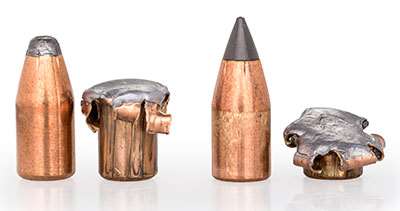
Penetration-testing successfully completed, I then moved on to function and accuracy work with all three rifles, but first a quick caveat. It is the policy of this magazine to, whenever circumstances allow, use only production guns in our evaluations. At the time that this story went to press, production ammunition for all three evaluated loads was already rolling off of the assembly lines at Winchester Ammunition, as were rifles from both CMMG and Ruger, however, the sample XPR Compact sent by Winchester Repeating Arms was a pre-production unit. Given that XPR production is expected to be in full swing by the time this reaches the reader, the decision was made to move forward with testing through a pre-production barrel so as to get this information to you prior to the start of 2019’s deer season.
The 350 Legend is not really shaped to facilitate reliable feeding (shoulders are an asset in this regard), yet throughout my testing I’ve experienced no issues with any of the three guns—when loading them from their respective magazines. While shooting the XPR, however, I did discover that I could induce a failure to feed nearly 100 percent of the time by singly loading a round directly into the ejection port; doing so caused the nose of the cartridge to hang up on the feed ramp consistently. As this is not a gun where such practice will regularly be employed, I think this is a relatively benign issue. CMMG warned me before my testing began that 350 Legend runs a bit dirtier than .223 Rem., and while my experience does confirm this, it was not so much as to have an impact on reliability during my 300-odd rounds of function-firing.
The SAAMI spec for the cartridge stipulates 1:16" right-hand-twist rifling, which Winchester indicated should provide the best accuracy across the entire span of available bullet weights, and the barrels of all three test rifles were cut to this rate. Accuracy—using Rifleman’s five-shot, five-group protocol—was solid but unspectacular, which is about what I expected of two hunting loads and an FMJ. The Winchester and CMMG test samples got the best results from the 180-gr. Power-Point load (the CMMG in particular had a noticeable preference for this ammunition), while the Ruger shot the smallest 25-shot average with the 150-gr. Deer Season XPs. Overall, the Power-Points (1.28") edged out the Deer Season (1.34") as the most consistently accurate load across all three firearms. Given the short-range application of the cartridge and the 8-10" target area of a deer’s vitals, 350 Legend possesses far more accuracy than is needed for the type of shooting in which it will principally be used.

Between all the various testing required for this story, I’ve shot a lot of 350 Legend in the past few months, including multiple marathon sessions of more than 100 rounds at a time. As a result of pulling all those triggers, I’ve become intimately familiar with this cartridge’s recoil impulse, and have come to view it as a primary selling point for the new chambering. Recoil anticipation is the death of accuracy; if you’re still thinking about how badly the last shot rocked you, your fundamentals are going to suffer on the next one. Totally disproportionate to its effect on game, the 350 Legend’s recoil is minimal enough that bracing for the kick never even entered my mind.
For the sake of a direct comparison, the 350 Legend-firing CMMG kicks just a sliver more than a 7.62x39 mm AK-47, and even the 6-lb. Ruger bolt-action was docile enough to permit extended sessions at the range with no discomfort. As such, the 350 Legend is a great, dare I say ideal, cartridge for a youth’s first center-fire—and not a bad choice for the rest of us either.
So, what does the future hold for 350 Legend? It has a lot going for it, and I think the potential for long-term success is there—maybe even enough to eventually live up to its rather vainglorious name. It’s an effective short-range hunting cartridge designed to function in essentially every type of action imaginable. It fills a legitimate hole in the cartridge pantheon, and (sorry .450 Bushmaster) represents a better mousetrap for straight-wall deer hunters. It is accurate and fun to shoot.
Developing a new cartridge may indeed be an uncertain proposition for an ammunition maker, but in the case of 350 Legend, I believe the calculus is pretty simple. If it is produced by Winchester in sufficient quantities that White Box on your local shelves can be counted on to always be there, at prices that rival .223 Rem. and beat the rest of the competition, and if the industry at large continues to buy-in—then I believe the cartridge has the legs to become a mainstay. The 350 Legend is a good, simple idea, and those are often the best kind.

Winchester XPR Compact
At the time of 350 Legend’s launch, licensing partner and fellow custodian of the Winchester name, Winchester Repeating Arms, announced that six XPR models (14 SKUs when you factor in the various available finishes and scope combo packages) would initially be offered chambered in the new cartridge. The XPR is the company’s entry-level bolt-action rifle platform—a push-feed action with a round-bodied receiver bedded within a molded polymer stock—and the Compact version shortens the base gun’s barrel length in non-magnum chamberings from 22" to 20" and the length of pull from 13¾" to 13". All of the guns feature Winchester’s single-stage MOA Trigger, a beefy three-lug bolt and a two-position safety with a bolt unlocking button. In order to make the XPR platform compatible with the 350 Legend, Winchester had to develop a new magazine, a new barrel and a new receiver with a slight chamfer cut into it to help guide the long, straight rounds to the chamber. Otherwise, the 350 Legend rifles are in all other ways standard XPRs. MSRP: $549. winchesterguns.com
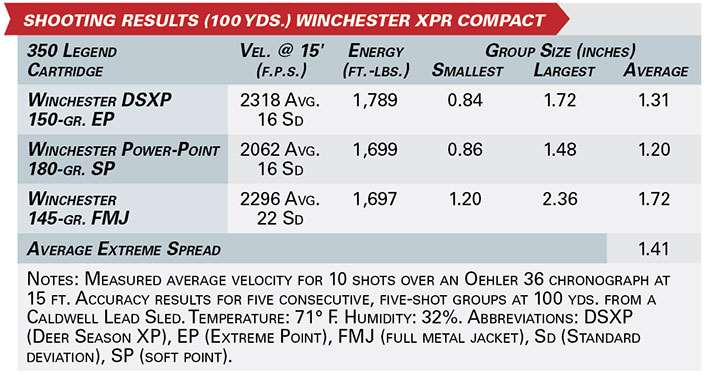

CMMG Resolute 300
CMMG is a maker of AR-platform guns that, unlike the great majority of the industry, has never been afraid to offer its rifles chambered in a host of different cartridges, and the manufacturer wasted no time in adding 350 Legend to its stable. A single day after the cartridge officially entered the scene, CMMG introduced three models of its Resolute series (100, 200 and 300) that would fire it. Functionally identical to each other but with features and furniture varying between the models—with the 300 used in this evaluation offering the most refined components—the 350 Legend-chambered Resolutes are direct-impingement semi-automatics with 16" barrels and carbine-length gas systems. With the exception of the barrel and the dedicated 350 Legend magazines (available in five- and 10-rounders, two of the latter are included), the rest of the guns use standard .223 Rem.-compatible AR-15 parts—including the bolt head, bolt carrier group and buffer assembly. For those who would prefer to build their own guns, in addition to finished rifles, CMMG is also offering complete upper receivers and individual barrels chambered for the new medium-bore cartridge. MSRP: $1,549. cmmginc.com
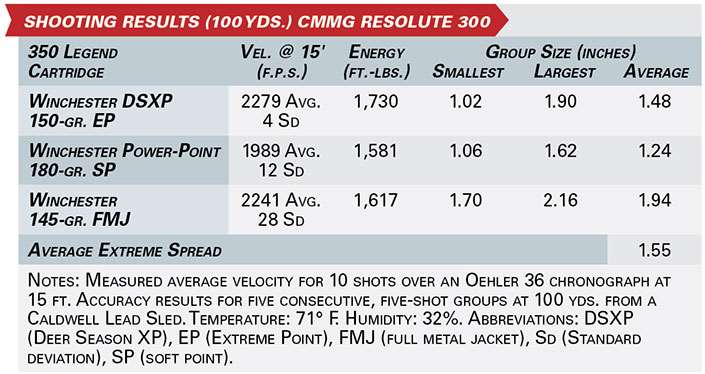

Ruger American Rifle Ranch
The Ranch subset of Ruger’s bolt-action American Rifle line is populated by models chambered to fire cartridges traditionally used in semi-automatics (such as .223 Rem., .300 Blackout, 7.62x39 mm and .450 Bushmaster) which is fitting, as the company introduced its two newest members of the family alongside a similarly 350 Legend-chambered AR-pattern rifle—and the guns feed from AR-style detachable box magazines. Utilizing a push-feed, 70-degree-throw action, a threaded (1/2x28 TPI) 16.38" barrel and Ruger’s two-stage Marksman Adjustable trigger, the two budget-friendly Ranch rifles differ only in their length-of-pull measurements (12½" for the compact and 13¾" for the fullsize) and overall lengths, with the longer model being used for this evaluation. A one-piece Picatinny rail scope base comes factory-installed, a two-position safety rides the gun’s tang, an AR-style magazine release button is located on the right side of the flat dark earth polymer stock and one five-round AR magazine ships with each rifle. Apart from the chambering-specific magazines, which Ruger worked with C-Products to design, reliable functioning with the cartridge only required company engineers to tweak the rifles’ feed-ramp geometry. MSRP: $549. ruger.com
